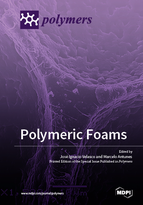Polymeric Foams
A special issue of Polymers (ISSN 2073-4360).
Deadline for manuscript submissions: closed (20 December 2018) | Viewed by 93520
Special Issue Editors
Interests: polymers; composites; foams; nanocomposites
Special Issues, Collections and Topics in MDPI journals
Interests: additives; aerogels; composites; conductivity; extrusion; films; foaming; foams; foils; fracture; graphene; ignifugation; membranes; molding; nanocomposites; nanoparticles; oxides; permeability; polyfunctional materials; polymers; processing; properties; resistance; silicates; structure; supercritical fluid
Special Issues, Collections and Topics in MDPI journals
Special Issue Information
Dear Colleagues,
Advances in nanotechnology have boosted the development of more efficient materials, with emerging sectors (electronics, energy, aerospace, among others) demanding novel materials to fulfil the complex technical requirements of their products. This is the case for polymeric foams, which may display good structural properties alongside functional characteristics through complex compositions and structures, in which a gaseous phase is combined with rigid ones, mainly based on nanoparticles, dispersed throughout the matrix.
In the last few years, there has been an important impulse in the development of “nanocomposite foams”, extending the concept of nanocomposite to the field of cellular materials. This, alongside the developments in new advanced foaming technologies, which have allowed generating new foams with micro, sub-micro and even nanocellular structures, has extended the applications of more traditional foams in terms of weight reduction, damping, thermal and/or acoustic insulation, to novel possibilities, such as electromagnetic interference (EMI) shielding.
This Special Issue considers recent research on novel polymer-based foams in all their aspects: design, composition, fabrication, microstructure, characterization and analysis, application and service behavior, recycling, etc.
Manuscripts related to the following topics will be welcomed in this Special Issue:
- Thermoplastic and thermosetting polymer foams.
- Biopolymer foams.
- Nanocomposite foams.
- Microcellular, sub-microcellular and nanocellular foams.
- Close-cell, open-cell and interconnected-cell foams.
- Unimodal and multimodal foams.
- Chemical and physical foaming methods.
- Recycling of foams.
- Biodegradable foams.
- Flame retardant foams.
- Thermally and electrically conductive polymer foams.
- New applications of foams, including electronics, batteries, fuel cells, catalysis, separation and filtration, EMI shielding, electrostatic discharge (ESD), electrostatic painting, tissue engineering, etc.
Dr. Marcelo Antunes
Prof. José Ignacio Velasco
Guest Editors
Manuscript Submission Information
Manuscripts should be submitted online at www.mdpi.com by registering and logging in to this website. Once you are registered, click here to go to the submission form. Manuscripts can be submitted until the deadline. All submissions that pass pre-check are peer-reviewed. Accepted papers will be published continuously in the journal (as soon as accepted) and will be listed together on the special issue website. Research articles, review articles as well as short communications are invited. For planned papers, a title and short abstract (about 100 words) can be sent to the Editorial Office for announcement on this website.
Submitted manuscripts should not have been published previously, nor be under consideration for publication elsewhere (except conference proceedings papers). All manuscripts are thoroughly refereed through a single-blind peer-review process. A guide for authors and other relevant information for submission of manuscripts is available on the Instructions for Authors page. Polymers is an international peer-reviewed open access semimonthly journal published by MDPI.
Please visit the Instructions for Authors page before submitting a manuscript. The Article Processing Charge (APC) for publication in this open access journal is 2700 CHF (Swiss Francs). Submitted papers should be well formatted and use good English. Authors may use MDPI's English editing service prior to publication or during author revisions.
Keywords
- Polymeric foams
- cellular composites
- nanocomposites foams
- functional foams
Related Special Issues
- Cellular Polymeric Materials in Polymers (4 articles)
- Polymeric Foams II in Polymers (15 articles)
- Polymeric Foams in Polymers (36 articles)








